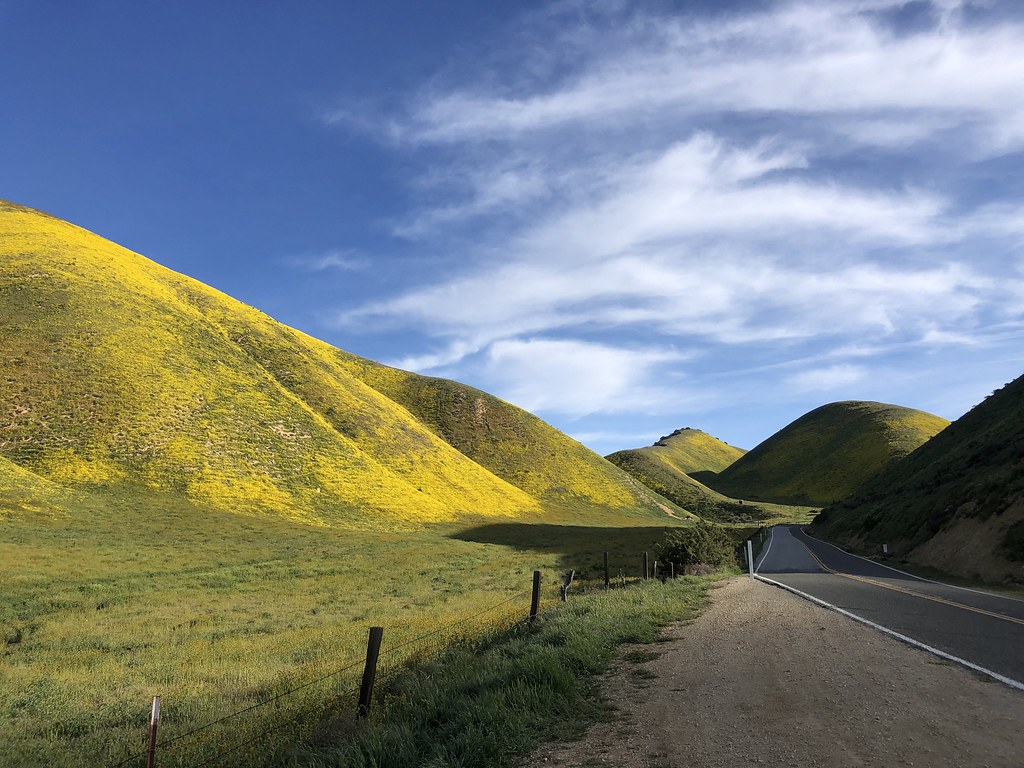
You would have thought I’d gotten enough California wildflowers on our stops at Antelope Valley, Lake Elsinore, and Anza-Borrego in March of 2019. Nope. I needed more, so in early April I went on a solo trip south to check out Carrizo Plain National Monument. Bare with me while I get all my California centered posts out of my system here. I had seen pictures of the mega bloom years before and had always wanted to check this place out, but it also freaked me out. Lots of people rent 4WD vehicles which I would recommend if you can. We got new and needed tires for the minivan and I figured I’d stay on the easy roads. Well, I almost ran myself over on the road to the visitor center when I stopped to check and see if I had a flat tire and forgot to put the car in park. I’m totally serious. No flat tire, but I’d describe big chunks of the ride around the monument like driving on a washboard on your rims. It didn’t help that I had my bike rattling around in the back of the car waiting to get ridden in Venice Beach.

On the way to see this giant field of Phacelias I thought I was going to be stranded with four flat tires. I also misread the map and took a road I should have probably avoided. The weirdest thing was seeing 45MPH speed limit signs when I was afraid to go over 5 without feeling like the car was going to fall apart. At least I had the super AAA membership that will tow you out of remote places you probably shouldn’t be driving in to begin with. Enough about my driving trauma.

The Carrizo Plain was delightfully uncrowded due to it’s remote location about 45 minutes off the I-5 almost halfway between Bakersfield and San Luis Obispo. It’s pretty darn isolated, so be sure to gas up and bring food and water. Just look at those tidy tips! They’re one of my favorite California native annuals, so to see so many of them in their natural habitat was pretty exciting.

Another favorite I’ve grown in the garden, creamcups. I pretty much lost it with excitement when I saw them. The Carrizo Plain is one of the only places to see California looking like it did before a bunch of folks set up massive monoculture agriculture sites all over the place. Seriously, it’s creepy to drive through miles and miles and miles of the same plant growing in a virtual desert.
Three hundred years ago, California’s Central Valley was vast grassland where antelope and elk grazed and wildflowers swept the spring landscape. Today, amid urban and agriculture development, a remnant remains in the Carrizo Plain National Monument.
Carrizo Plain National Monument is one of the best kept secrets in California. Only a few hours from Los Angeles, the Carrizo Plain offers visitors a rare chance to be alone with nature. Some visitors say you can “hear the silence.” The plain is home to diverse communities of wildlife and plant species including several listed as threatened or endangered and is an area culturally important to Native Americans.
https://www.blm.gov/programs/national-conservation-lands/california/carrizo-plain-national-monument

Surprise, surprise a chemical company was processing tons of sodium sulfate from this amazing spot over 100 years ago. I’m glad they stopped, but the government website’s description of the lake is just weird. Like what/who is McKittrick and who wrote this blurb? I fixed the multiple spelling issues in the quote below.
A normally dry lake bed, Soda Lake covers an area of about 3,000 acres. It is the largest remaining natural alkali wetland in southern California and the only closed basin within the coastal mountains. Soda Lake concentrates salts as water is evaporated away, leaving white deposits of sulfates and carbonates. Despite this harsh environment, small plant and animal species are well adapted to this setting. In the 1880’s, the saline deposits of Soda Lake were mined for use at nearby cattle ranches as salt licks or for preserving meat. Prior to 1908 the Carrisa Chemical Company constructed a 600 ton per month capacity processing plant to recover sodium sulphate. Once the salts were processed they were sacked and hauled to McKittrick for distribution.
https://www.blm.gov/programs/national-conservation-lands/california/ct

Good old broomrape. I still can’t get over the scary common name from olden times for this family of plants. I had no idea it was sort of a parasite.
Like other related plants in the family, this is a hemiparasite which derives some of its nutrients directly from the roots of other plants by injecting them with haustoria; this is the reason for its small, reduced leaves. Therefore, it is almost always planted with a perennial species to serve as the host plant.
https://calscape.org/Castilleja-exserta-()


The baby blue eyes were past their prime, but I was happy to see a few still hanging out. I’ve seen pictures of blue hillsides here that are incredible.

Definitely go see the blooms here if you have a chance. They’re typically going off in March or early April depending on how much rain fell in winter. Do some research before you go just in case. In the summer it’s a hellishly hot and brown place according to a nice young man working there.

It’s incredibly beautiful. Hopefully, the gray clouds in some of your shots meant it was relatively cool. You’re braver than I am to take that trek alone but your photos are fantastic.